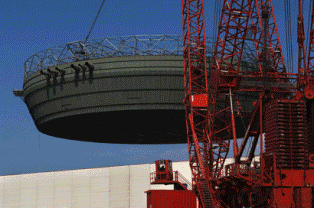Olkiluoto 3 start-up 'may be postponed until 2012'
17 October 2008
Teollisuuden Voima Oyj (TVO) has announced a further delay in the completion of the third reactor at Olkiluoto, Finland, saying that the unit may not be commissioned until 2012.
 |
| Construction of Olkiluoto 3 - slower than planned (Image: Areva) |
In a statement, the company said that "based on the present time schedule information received from the plant supplier, Areva-Siemens, the reactor plant civil construction works will take several months longer than earlier expected." TVO added, "This additional time required for the civil construction works will impact the time schedule of the installation and erection works."
TVO noted, "The turn-key plant supplier is responsible for the time schedule and for the acceleration measures required for keeping the schedule. According to the schedule information submitted by the plant supplier, TVO estimates that the start-up of the plant may be postponed until 2012."
The work force on the construction site has doubled in 2008 to some 4000. The manufacture of several main components has now been completed. The manufacture of the reactor pressure vessel head by Mitsubishi Heavy industries (MHI) in Japan has been completed and it recently passed pressure tests. The first steam generator has also been manufactured. Meanwhile, the forging for the reactor cooling pipes has been validated. Also, the turbine building is nearing completion, with all the main components either on site or already in place. Civil construction works at the reactor building continue. However, work on the nuclear island has slowed markedly, primarily due to an apparent problem constructing the reactor's unique double-containment structure.
TVO's Reijo Sundell told a group touring the Olkiluoto plant site today, "We don't know the real reasons." The Finnish building regulations regarding this have been known for a long time, he added, but said "the consortium has no drawings, no plans of what to do for construction [of the double containment]." He added that, "It is very important to get a reliable and safe power plant. We can have a delay now - problems in operation are more expensive." TVO shareholders, he said, will not make a decision on building a fourth reactor at Olkiluoto until the third unit is finished and making money.
TVO commented that "despite of the fact that a lot has been done, additional delay postponing the start-up of the plant has occurred," adding that "the plant supplier is naturally responsible for the time schedule and possible cost increase." It added, "TVO has a fixed-price plant supply contract and the company is not in a process of agreeing with the plant supplier upon sharing Areva's losses, contrary to the information presented in the media."
Areva said in a statement that, "Confronted with construction delays, the Areva-Siemens consortium succeeded in convincing TVO that a number of measures were required to accelerate and improve the program. TVO will be chiefly responsible for implementing these measures." The company added, "The Areva-Siemens consortium will update the construction schedule by the end of the year, depending on the progress made."
Olkiluoto 3 is a 1600 MWe European Pressurized Water Reactor (EPR) and will be the first Generation III+ nuclear power reactor in the world when complete. Work began on the project in 2005, but various delays have seen the startup date pushed back from the originally scheduled 2009 date. TVO announced in August 2007 that delays in construction had likely pushed the completion date into 2011. In December 2007, the company said that construction of the reactor would not be completed until summer 2011.
As the first Evolutionary PWR (EPR) - a design produced by France's Areva, which includes the former nuclear business of Germany's Siemens - it has suffered from first-of-a-kind problems. The Areva-Siemens consortium building the unit for a fixed price of €3 billion ($4.1 billion) has faced many challenges.
First to come to light were irregularities in foundation concrete, which caused work to slow on site for months. Later it was found that subcontractors had provided heavy forgings that were not up to project standards and which had to be re-cast.